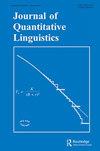最优编码与Zipfian定律的起源
IF 1.7
2区 文学
0 LANGUAGE & LINGUISTICS
引用次数: 35
摘要
标准信息论中的压缩问题包括将尽可能短的代码分配给数字。在这里,我们考虑了在任意编码方案下的最优编码问题,并表明它预测了Zipf缩写定律,即自然语言中更频繁的单词更短的趋势。我们将这一结果应用于研究在所谓的非奇异编码下的最优编码,该方案不保证唯一分割,但代码代表不同的数字。最优非奇异编码预测单词的长度应该近似于其频率秩的对数增长,这再次符合Zipf的缩写定律。结合最大熵原理的最优非奇异编码也预测了齐普夫的秩频率分布。此外,我们关于最优非奇异编码的发现挑战了关于随机类型的普遍信念。事实证明,随机打字实际上是一种最佳的编码过程,这与人们普遍认为它脱离了成本削减的考虑形成了鲜明对比。最后,我们讨论了最优编码对Zipfian定律以及其他语言定律的紧凑理论的构建的影响。本文章由计算机程序翻译,如有差异,请以英文原文为准。
Optimal Coding and the Origins of Zipfian Laws
ABSTRACT The problem of compression in standard information theory consists of assigning codes as short as possible to numbers. Here we consider the problem of optimal coding – under an arbitrary coding scheme – and show that it predicts Zipf’s law of abbreviation, namely a tendency in natural languages for more frequent words to be shorter. We apply this result to investigate optimal coding also under so-called non-singular coding, a scheme where unique segmentation is not warranted but codes stand for a distinct number. Optimal non-singular coding predicts that the length of a word should grow approximately as the logarithm of its frequency rank, which is again consistent with Zipf’s law of abbreviation. Optimal non-singular coding in combination with the maximum entropy principle also predicts Zipf’s rank-frequency distribution. Furthermore, our findings on optimal non-singular coding challenge common beliefs about random typing. It turns out that random typing is in fact an optimal coding process, in stark contrast with the common assumption that it is detached from cost cutting considerations. Finally, we discuss the implications of optimal coding for the construction of a compact theory of Zipfian laws more generally as well as other linguistic laws.
求助全文
通过发布文献求助,成功后即可免费获取论文全文。
去求助
来源期刊

Journal of Quantitative Linguistics
Multiple-
CiteScore
2.90
自引率
7.10%
发文量
7
期刊介绍:
The Journal of Quantitative Linguistics is an international forum for the publication and discussion of research on the quantitative characteristics of language and text in an exact mathematical form. This approach, which is of growing interest, opens up important and exciting theoretical perspectives, as well as solutions for a wide range of practical problems such as machine learning or statistical parsing, by introducing into linguistics the methods and models of advanced scientific disciplines such as the natural sciences, economics, and psychology.
 求助内容:
求助内容: 应助结果提醒方式:
应助结果提醒方式:


